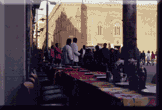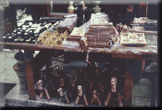 |
 |
 |
|
|||
|
The Streets of Cairo When I checked into my hotel room in Cairo, I felt compelled to record the sound outside my window, not out of any sense of journalistic duty, but out of sheer amazement. SOUNDS OF THE CAIRO STREETS That's Cairo, a throbbing, honking, kinetic, ancient, modern, exotic, filthy, elegant, sacred, clanging mess of a place that seduces with coal-black, Cleopatric eyes while at the same time grabbing you by the lapels. 
Take the 700 year-old Khan al Khalili, for instance, one of the city's oldest bazaars. Packed into a one and half-square mile section of medieval Cairo, this labyrinthine, chaotic, and colorful marketplace is best known for its goldsmiths. Here, dozens of craftsman, huddled in cave-like shops, hammer out hundreds of rings and other trinkets each day, a scene practically identical to one described in A Thousand Miles Up the Nile, the definitive Victorian-era guidebook to Egypt by British travel writer Amelia Edwards.

Low key but persistent salesmanship is still the way they do business in the Khan al Khalili. Then there's the time-honored rule endemic to all Arab bazaars, haggling,
Jewelry shop owner Iman Achmut says that asking 15 or so Egyptian pounds for a 10 pound item is not out of the question, and if the buyer ends up paying 12, he's still happy.

Taking advantage of hapless tourists has always been something of a cottage industry in Cairo. During the French occupation of the city in 1798, artist Dominique Vivant Denon commented on one of the most popular scams, snake charming.
Denon remained immune as well to the allure of the harem and its belly dancers, whose gyrations he scorned as a "gross and indecent expression of sensual intoxication." Presumably, the average foot soldier was more appreciative of the effort. Today, belly dancers perform in five-star hotels instead of on the street. But not far from the Khan al Khalili, in what was once a sultan's mausoleum, traditional dance of another kind still mesmerizes the crowds.

A hundred years ago, Victorian-era travel writer Amelia Edwards was on hand here for a performance of the whirling dervishes, members of a Sufi Muslim sect whose dance, they say, brings them closer to God.
So, when in Cairo, keep one eye out for whirling dervishes, another on your wallet, but don't let either distract you from the overall enjoyment of what surely remains one of the most stimulating cities in the world. In Cairo, I'm Tom Verde for The Savvy Traveler Thanks go to Marketplace Productions, Helen Palmer, Robert Da Pont and David Jaffee, Director of the National Theater Institute at the Eugene O'Neill Theater Center in Waterford, Connecticut for their help in this production. Join us next week on The Savvy Traveler as we explore the domes and minarets of some of Cairo's most famous mosques.
|
 | American Public Media Home | Search | How to Listen ©2004 American Public Media | Terms of Use | Privacy Policy |
